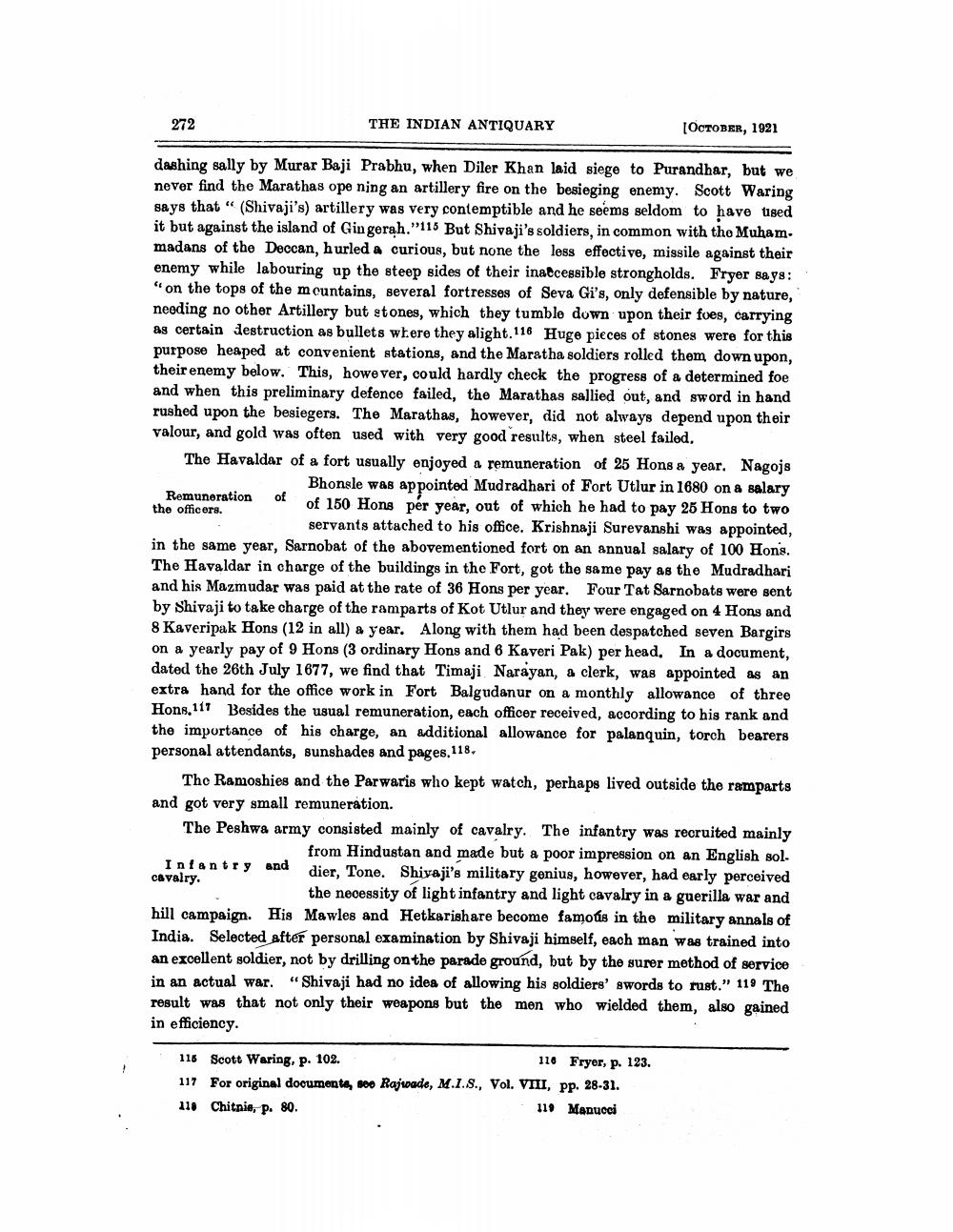________________
272
THE INDIAN ANTIQUARY
[OCTOBER, 1921
servants
dashing sally by Murar Baji Prabhu, when Diler Khan laid siege to Purandhar, but we never find the Marathas opening an artillery fire on the besieging enemy. Scott Waring gays that (Shivaji's) artillery was very contemptible and he seems seldom to have tised it but against the island of Gin gerah."116 But Shivaji's soldiers, in common with the Muham. madans of the Deccan, hurled a curious, but none the less effective, missile against their enemy while labouring up the steep sides of their ina cessible strongholds. Fryer says: "on the tops of the mountains, several fortresses of Seva Gi's, only defensible by nature, needing no other Artillery but stones, which they tumble down upon their foes, carrying as certain destruction as bullets where they alight 116 Huge pieces of stones were for this purpose heaped at convenient stations, and the Maratha soldiers rolled them down upon, their enemy below. This, however, could hardly check the progress of a determined foe and when this preliminary defence failed, the Marathas sallied out, and sword in hand rushed upon the besiegers. The Marathas, however, did not always depend upon their valour, and gold was often used with very good results, when steel failed. The Havaldar of a fort usually enjoyed a remuneration of 25 Hons a year. Nagojs
Bhonsle was appointed Mudradhari of Fort Utlur in 1680 on a salary Remuneration of of 150 Hong per year, out of which he had to pay 25 Hong to two the officers.
servants attached to his office. Krishnaji Surevanshi was appointed, in the same year, Sarnobat of the abovementioned fort on an annual salary of 100 Hons. The Havaldar in charge of the buildings in the Fort, got the same pay as the Mudradhari and his Mazmudar was paid at the rate of 36 Hons per year. Four Tat Sarnobats were sent by Shivaji to take charge of the ramparts of Kot Utlur and they were engaged on 4 Hons and 8 Kaveripak Hons (12 in all) a year. Along with them had been despatched seven Bargirs on a yearly pay of 9 Hons (3 ordinary Hons and 6 Kaveri Pak) per head. In a document, dated the 26th July 1677, we find that Timaji Narayan, a clerk, was appointed as an extra hand for the office work in Fort Balgudanur on a monthly allowance of three Hong, 111 Besides the usual remuneration, each officer received, according to his rank and the importance of his charge, an additional allowance for palanquin, torch bearers personal attendants, sunshades and pages. 118.
The Ramoshies and the Parwaris who kept watch, perhaps lived outside the ramparts and got very small remuneration. The Peshwa army consisted mainly of cavalry. The infantry was recruited mainly
from Hindustan and made but a poor impression on an English sol. antry and dier, Tone. Shivaji's military genius, however, had early perceived cavalry.
the necessity of light infantry and light cavalry in a guerilla war and hill campaign. His Mawles and Hetkarishare become famous in the military annals of India. Selected after personal examination by Shivaji himself, each man was trained into an excellent soldier, not by drilling on the parade ground, but by the surer method of service in an actual war. “Shivaji had no idea of allowing his soldiers' swords to rust." 119 The result was that not only their weapons but the men who wielded them, also gained in efficiency.
116 Scott Waring, p. 102.
110 Fryer, p. 123. 117 For original documente, son Rajwade, M.I.S., Vol. VIII, pp. 28-31. 118 Chitnie, p. 80.
119 Manucci




